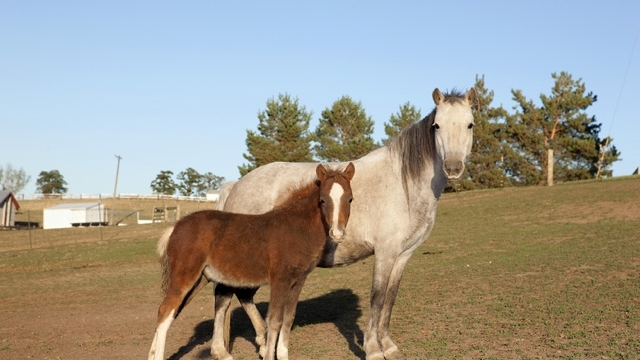Equine Infectious Anemia

Equine infectious anemia (EIA) is a viral, and sometimes fatal, disease that only affects equids (horses, ponies, zebras, mules, and donkeys). There is no treatment. EIA can be difficult to recognize and may be confused with other diseases. It is found in nearly all countries worldwide, including the United States. It is a reportable animal disease in all States. It is not a threat to human health.
Clinical signs range from mild to severe and appear within a few weeks after infection. However, it may take 60 days or more for the horse to test positive.
Infected animals that survive the disease become virus carriers and can infect other equids for life. They must either be euthanized or permanently isolated from other equids to prevent transmission. Carriers may also experience clinical flare-ups, often following stress or strenuous work.
- Fever
- Decreased appetite
- Severe anemia
- Sudden death
- Jaundice (yellow discoloration of mucous membranes)
- Rapid breathing, rapid heart rate
- Swollen limbs
- Bleeding from the nose or red/purple spots on mucous membranes
- Blood-stained feces
Chronically infected horses may show no clinical signs.
Biting, blood-feeding flies, such as horseflies or deerflies, can spread the virus from one animal to another. Historically, this has been the primary way EIA has spread. Animals can also get the virus from unclean or re-used needles and syringes, blood transfusions, and contaminated instruments, such as IV sets, dental instruments, and tattoo equipment. This type of human-facilitated transmission is now the most common way EIA spreads in the United States, particularly among current or former Quarter Horse racehorses, many with ties to unsanctioned (bushtrack) racing.
To prevent the spread of this disease:
- Control biting flies on your property to reduce your animal's exposure.
- Never reuse needles, syringes, or IV sets.
- Only use licensed and approved blood products.
- Make sure blood transfusions are performed only by licensed veterinarians using blood products from donor horses that have tested negative for EIA and other blood-borne infections like equine piroplasmosis.
- Test your horses, ponies, mules, and donkeys annually for EIA.
- Call your veterinarian if you suspect EIA in any equid. Immediately move horses, ponies, mules, or donkeys that you think might have EIA at least 200 yards away from other equids on your property.
Report Signs of Animal Disease
Producers or owners who suspect an animal disease should contact their veterinarian to evaluate the animal or herd. Find an accredited veterinarian.
Animal health professionals (veterinarians; diagnostic laboratories; public health, zoo, or wildlife personnel; and others) report diagnosed or suspected cases of nationally listed reportable animal diseases to APHIS Area Veterinarians in Charge and to the State animal health official as applicable under State reporting regulations.
Controlling Equine Infectious Anemia
Efforts to control EIA in the United States started in 1972. Since then, the estimated national prevalence of EIA infection in the U.S. equine population has dropped from nearly 4 percent in 1972 to 0.004 percent.
- 2023 Summary of Equine Infectious Anemia Cases in the United States
- 2022 Summary of Equine Infectious Anemia Cases in the United States
- 2021 Summary of Equine Infectious Anemia Cases in the United States
- 2020 Summary of Equine Infectious Anemia Cases in the United States
- 2019 Summary of Equine Infectious Anemia Cases in the United States
- 2018 Summary of Equine Infectious Anemia Cases in the United States
To request copies of previous years' reports, send an email to aphisweb@usda.gov.
The Uniform Methods and Rules (70.92 KB) contains minimum recommended standards for detecting, controlling, and preventing EIA.
- VSG 5201.1: Approval of Labs To Conduct EIA Testing (426.82 KB)
- VSG 15201.1 Official Documents:
- VSG 15201.1 Outreach, Training, and Explanatory Information:
- Current List of Approved EIA Laboratories (160.35 KB)
- List of Approved EIA Test Forms
Only Category II accredited veterinarians, who are authorized to perform accredited duties in the State in which samples are collected, may submit samples to an APHIS-approved laboratory. You must include your National Accreditation Number (NAN) with every submission.
Check Your Accreditation Status
Submitting Samples
Accredited veterinarians must complete a VS 10-11 form either electronically or by paper using one of the USDA-approved systems or forms from the List of Approved EIA Test Forms and submit samples to APHIS-approved labs. Contact your Area Veterinarian in Charge with questions. Please request paper copies of the form from your National Veterinary Accreditation Program coordinator. Note: The form is not available as a fillable PDF.
Instructions for completing VS Form 10-11 (version December 2020)
Instructions for completing VS Form 10-11 (version February 2018)
Tips for Accredited Veterinarians—Do’s and Don’ts
Post-Mortem Lesions
Spleen, liver, and abdominal lymph nodes may be enlarged. Mucous membranes can be pale. In chronic cases, emaciation may also be noted. However, horses that die between clinical episodes may have no gross lesions.

